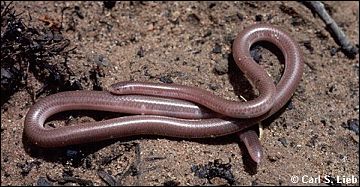
Hmmm. Good sized earthworm. Or is it an earthworm?—looks a little bit strange. And what are those two black dots at one end? Can it be?—Yes, it is! It's a blind snake, and contrary to its common name, those two black dots are eyes. Not very good eyes, mind you, but eyes nonetheless.
Confusion with an earthworm is understandable. Shape, including a head merging with the body without a hint of a neck, and color fit the mind's picture of a nightcrawler pretty well. Moreover, you'll usually find them in places where you might expect worms, hidden under trash. They move above ground almost exclusively during the dark of night, and so most people have never seen them.
They look the way they do because they are adapted to a particular way
of life. Blind snakes do most of their foraging underground and have a diet centered on
the eggs and pupae of ants and termites. Underground, there is no need for acute
vision, and their body shape slips easily into small, subterranean tunnels as they seek
their prey. 
Contributor: Arthur H. Harris, Laboratory for Environmental Biology, Centennial Museum, University of Texas at El Paso.
Desert Diary is a joint production of the Centennial Museum and KTEP National Public Radio at the University of Texas at El Paso.

Western Blind Snake, Leptotyphlops humilis. Photograph by Carl S. Lieb.